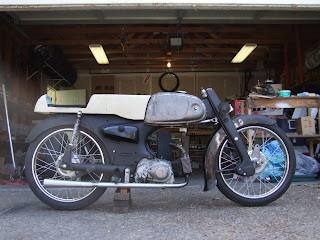One of the keys to building this bike was to keep it somewhat "period correct" with regards to modifications. I was hoping to build it like it would be built back in the 60s. One of the main items I knew that would need to be built or modified would be the gas tank and seat. The seat would obviously need to be made to accommodate my skinny butt when tucked down in my Bonneville speed demon posture. That means there is a huge gap between the seat and tank.
Option 1 is to buy a reproduction tank like on all the vintage road race bikes. Something like the tank on a CR110 Honda immediately comes to mind. Besides the fact a reproduction tank like that costs more than the entire bike did, I didn't entirely like the look of it. Well, I loved the look of the long skinny tank, but it just didn't fit in with the hot rod theme I was going for. Besides, the stock tank was decent, as were the chrome panels and rubber knee pads. Option 2 is to build a tank extension. Basically, a fake extension that would fill up the gap, but also be strong enough to support me laying my belly and chest on it, and support the grip from my knees as I squeeze down on it when tucked.
I decided to go with option 2.
Having made a similar rear seat section for the Bridgestone 90 Racer project, I had an idea of the generic size and proportions.
Photo of the Bridgestone rear seat section for reference:
I started off with a cardboard template, to get an idea how big the final product would need to be. I then got to cutting and grinding and drilling and welding, and made up a very simple frame that mounts to the bike using the rear gas tank hold down bolt, and the upper rear shocks mounts for support. It is basically a 1" angle iron craddle that the tank extension/seat will then bolt to, and then be able to be removed as one piece.
With dimensions in hand, I visited the local craft store for some crafters foam. These foam blocks are available in various sizes, and as it turns out these little brick shaped pieces matched up with the width and height I was looking for.
Using a scrap piece of wood, I glued and screwed the foam blocks to each other, then to the wood in a rough shape. I then proceeded to carve and sand the foam into the shape I was looking for. It had a little bit of taper from bottom to top, and I made the rear portion of the seat have the usual cafe' racer bubble shape.
Foam bricks carved and sanded to shape:

After the foam mold was shaped to satisfaction, I got out the fiberglass and resin. I precut about 4 layers worth of cloth, using both 8 oz bi-directional weave and some thicker chop mat for added thickness. It was a fairly warm day, so I had to mix the resin in smaller batches and work quick. I wouldn't say it was the best job I've ever done, but I knew it would require a lot of finish work anyways to make it smooth and pretty.
After it setup, i popped the mold off the wood, and removed the bottom layer of foam bricks. This was the underside of the part, which would get mounted to the angle iron base. I then added a few more layers of fiberglass to essentially create a honeycomb of fiberglass and foam. The main section of the tank extension, and the rear tail bubble are completly filled with foam, and surrounded by fiberglass. the result is a very strong and stable part that can support some weight.
I then trimmed the part using some basic angle grinders and thick sheet metal sheers. I gave the bottom edge a little shape to match up with the rubber knee pad on the stock gas tank, while keeping the bottom edge just tall enough to completely hide the angle iron frame work underneath. After a bit of final grinding and fitting, I mounted the seat to the frame work, and then mounted it to the bike.
Raw fiberglass part on bike for test fitting
I let the part setup for a couple weeks before I started to do some finish body work to it. Using some good 'ol fashion body filler, I was able to clean up the surface. Luckily I still had my body filler scrapers in the toolbox, since the easiest time to do rough finishing on filler is right after it starts to setup, as it can be scraped off like a cheese grater, in little shavings.
Filler is a pain in the butt to sand, so anything to minimize sanding is worth it
It still needs some finish work in a few sections, but you can see the overall look of the tank extension and seat as it is mounted on the bike. I cut out a piece of 1/2" thick foam rubber for the cushion, which will just be spray glued down to the seat pan, with four small holes to access the bolts that secure the seat to the frame work underneath.
 Here is a shot with the intrepid rider on board showing off his not-so-legal slippers and boxer shorts:
Here is a shot with the intrepid rider on board showing off his not-so-legal slippers and boxer shorts:
I'm still contemplating the next project, but I'm thinking it might be a small front fender to help keep the salt spray off the engine, bike, and rider.
Chris H.




















































